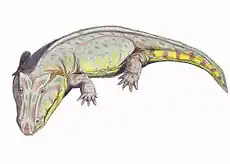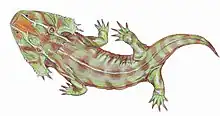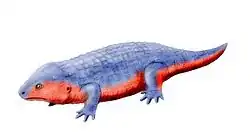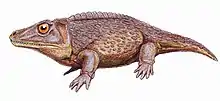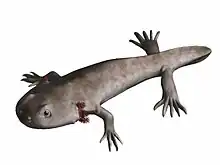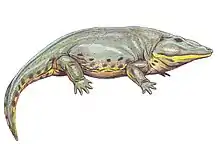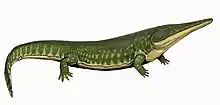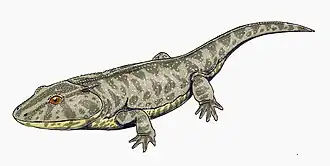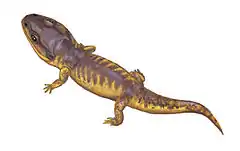| Sangaia Temporal range: Early Triassic ~ | |
|---|---|
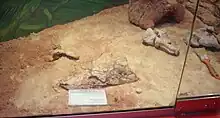 | |
| Sangaia lavinai, at Museum of Geological History of Rio Grande do Sul, found in Rota Paleontológica | |
| Scientific classification | |
| Domain: | Eukaryota |
| Kingdom: | Animalia |
| Phylum: | Chordata |
| Class: | Amphibia |
| Order: | †Temnospondyli |
| Suborder: | †Stereospondyli |
| Family: | †Rhytidosteidae |
| Genus: | †Sangaia Dias-da-Silva & Marsicano, 2006 |
| Species | |
| |
| Synonyms | |
| |
Sangaia is an extinct genus of rhytidosteid temnospondyl from the early Triassic period of Rio Grande do Sul, Brazil. It is known from the holotype UMVT 4302, the left half of a partial skull, a partial palate, from the paratype UMVT 4303, a partial right palatal fragment and from the referred specimens PV 0497 T and MCN PV 2606, skull fragments, recovered from the Sanga do Cabral Formation in the Rośario do Sul Group.[1]
Taxonomy
This taxon originally was named Cabralia lavinai by Sérgio Dias-da-Silva, Claudia Marsicano and Cesar Leandro Schultz in 2006 but this name was preoccupied by the Brazilian moth Cabralia (Moore, 1882).[1] Thus, Dias-da-Silva and Marsicano proposed Sangaia as a replacement generic name later in 2006.[2]
References
- 1 2 Sérgio Dias-da-Silva; Claudia Marsicano; Cesar Leandro Schultz (2006a). "Rhytidosteid temnospondyls in Gondwana: a new taxon from the Lower Triassic of Brazil". Palaeontology. 49 (2): 381–390. doi:10.1111/j.1475-4983.2006.00545.x. hdl:11336/93652.
- ↑ Sérgio Dias-da-Silva; Claudia Marsicano (2006b). "Sangaia, a replacement generic name for the rhytidosteid temnospondyl Cabralia, a preoccupied name". Journal of Vertebrate Paleontology. 26 (4): 1004. doi:10.1671/0272-4634(2006)26[1004:SARGNF]2.0.CO;2. hdl:11336/93007.
This article is issued from Wikipedia. The text is licensed under Creative Commons - Attribution - Sharealike. Additional terms may apply for the media files.
